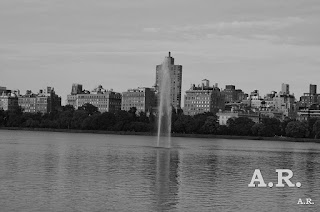A tourist in New York City with photo camera. Central Park. A tour.
Un paseo alrededor de Central Park permite encontrarnos con la gente que disfruta de ese magnífico lugar de paseo.
Central Park is an urban park in the central part of the borough of Manhattan, New York City.
It was initially opened in 1857, on 778 acres (315 ha) of city-owned
land, later expanding to its current size of 843 acres (341 ha).
In 1858, soon-to-be famed national landscapers and architects, Frederick
Law Olmsted and Calvert Vaux, won a design competition
to improve and expand the park with a plan they titled the "Greensward
Plan". Construction began the same year, continued during the American
Civil War further south, and was completed in 1873. It was designated a
National Historic Landmark (listed by the U.S. Department of the
Interior and administered by the National Park Service)
in 1962. The Park was managed for decades by the New York City
Department of Recreation and Parks and is currently managed by the
Central Park Conservancy under contract with the municipal government in
a public-private partnership.
Lakes
Central Park is home to seven bodies of water, all
artificial. The main lake is the Jacqueline Kennedy Onassis Reservoir,
so named since 1994.
Its construction lasted from 1858 to 1862. Covering an area of 42.9
hectares (106 acres) between 86th and 96th Streets, the reservoir
reaches a depth of more than 40 feet (12 m) in places and contains about
1 billion US gallons (3.8 billion litres) of water.The Reservoir is best known to New Yorkers for the jogging track around
it. The Reservoir is by far the largest lake in Central Park,
surpassing the other three artificial lakes.
The Ramble and Lake south of the Great Lawn
covers nearly 7.3 hectares (18 acres). Built on a former swamp, it was
designed by Olmsted and Vaux to accommodate boats in the summer and ice
skaters in winter. The Lake was opened to skaters in December 1858,
while the rest of the park was still under construction. At the northern end of the park, at 110th Street, the Harlem Meer,
named in honor of one of the first communities in the region, covers
nearly 4.5 hectares (11 acres). A wooded area surrounded by oak,
cypress, and beech trees, it was built after the completion of the
southern portion of the park. Harlem Meer also allows visitors to fish,
provided that they release the fish later. In the southeast corner is the Pond,
with an area of 1.4 hectares (3.5 acres). The Pond is located near one
of the busiest entrances to Central Park and is under sea level, which
helps mitigate the different sounds of the city, and create a startling
atmosphere of calm in the heart of New York.
R201506
Recuerde que haciendo click en la foto se ve a mayor tamaño






